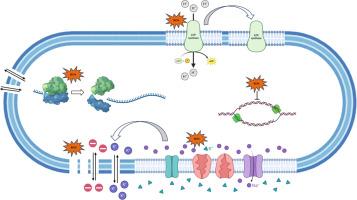压电催化剂作为抗菌剂:病原菌控制的一个有前途的前沿
IF 5.4
Q2 ENGINEERING, ENVIRONMENTAL
引用次数: 0
摘要
全球抗菌素耐药性(AMR)的升级对公共卫生构成严重威胁,挑战了传统抗生素治疗的有效性。这篇综述探讨了压电催化剂作为抗菌药物的新潜力,为减轻AMR提供了一种创新的方法。压电催化材料能够在机械应力下产生活性氧(ROS),是一种很有前途的对抗致病菌的方法。本文分析了压电催化剂的作用机制,如细胞壁和膜破坏、生物膜降解、细菌应激反应的诱导以及对细胞功能的干扰,以突出其靶向抗菌作用。此外,探索了压电催化剂在医疗,环境和水净化系统中的不同适用性,强调了它们在需要持续抗菌作用的环境中的相关性。除了这些作用之外,压电催化剂在能量收集、传感技术、催化反应器和生物医学工程方面也具有潜力。因此,压电催化剂成为先进的无抗生素策略的有前途的贡献者,在学术研究和工业应用中促进可持续的抗菌实践。本文章由计算机程序翻译,如有差异,请以英文原文为准。

Piezocatalysts as antimicrobial agents: A promising frontier in pathogenic bacteria control
The global escalation of antimicrobial resistance (AMR) poses a critical threat to public health, challenging the effectiveness of conventional antibiotic treatments. This review explores the novel potential of piezocatalysts as antimicrobial agents, offering an innovative approach to mitigating AMR. Piezocatalytic materials, capable of generating reactive oxygen species (ROS) under mechanical stress, present a promising method to counteract pathogenic bacteria. Mechanistic insights into the actions of piezocatalysts such as cell wall and membrane disruption, biofilm degradation, induction of bacterial stress responses, and interference with cellular functions are analyzed to highlight their targeted antimicrobial effects. Furthermore, the diverse applicability of piezocatalysts across medical, environmental, and water purification systems is explored, underscoring their relevance in contexts requiring sustained antimicrobial action. In addition to these roles, piezocatalysts hold potential in energy harvesting, sensing technologies, catalytic reactors, and biomedical engineering. Piezocatalysts thus emerge as promising contributors to advanced, antibiotic-free strategies, promoting sustainable antimicrobial practices within both academic research and industrial applications.
求助全文
通过发布文献求助,成功后即可免费获取论文全文。
去求助
来源期刊

Journal of hazardous materials advances
Environmental Engineering
CiteScore
4.80
自引率
0.00%
发文量
0
审稿时长
50 days
 求助内容:
求助内容: 应助结果提醒方式:
应助结果提醒方式:


